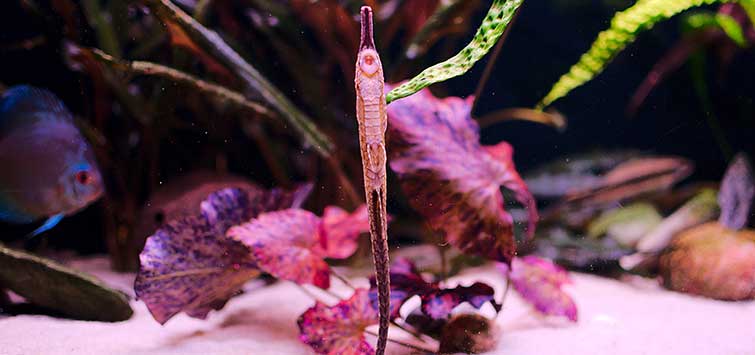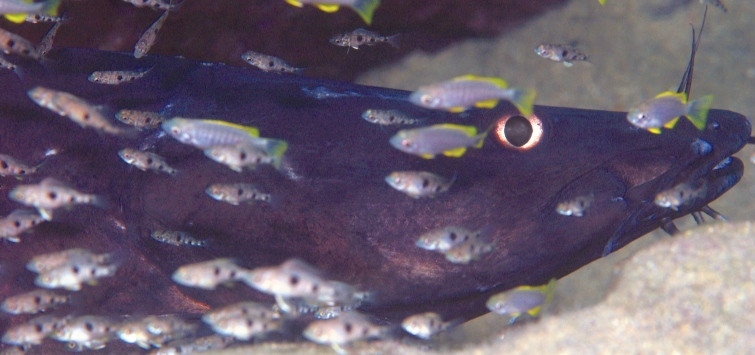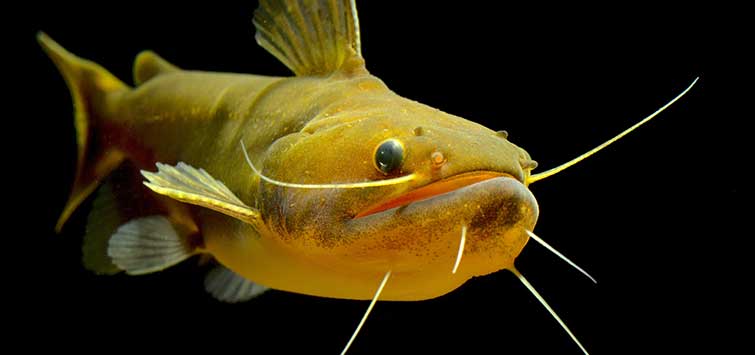Sticks and Stones: My Adventures in Raising Stick Catfish
Author: Jim Benfer
With their unique looks and placid personalities, stick catfish can play a starring role in a setup dedicated to their needs. They can also serve as a challenging breeding project for an advanced fish breeder.
Fascinating Stick Catfish
I have always been fascinated by tropical fish. As a boy, I would venture to my local pet store to pick up a copy of Tropical Fish Hobbyist (back when it came in booklet size) and read with awe the accounts of various collectors bringing back exotic species from the Amazon. Then I would stare into the 10-gallon tanks of the store and imagine myself doing the same, bringing the fish home to observe their behavior firsthand. Though I have not been to the Amazon, I have been able to create that environment in my own aquaria. Having watched precious habitat for species being destroyed over time, I have come to the conclusion that efforts like my own and that of other enthusiasts to conserve, breed, and share information about these increasingly rare species are vital to their survival. It is with these conservator-aquarists that I share my experience with stick catfish.
The common stick catfish (Farlowella vittata)is a curious creature. I hesitate to use the word “common” in regard to this genus because you won’t normally find it at your local pet store. Stick catfishare in fact rare among aquarists, with the exception of tropical catfish aficionados. They are not for beginning aquarists due to their rather finicky requirements for food, habitat, and tank companions. Some great qualities of stick catfish are that they will not obtain the enormous size of a Hypostomus plecostomus or exhibit the rambunctious behavior of some vigorous catfishes. In addition, they are excellent glass cleaners and are peaceful, fascinating pets.
Natural History
Stick catfish of the genus Farlowella are a broad group of at least 37 nominal species of poorly known sedentary catfish that live in moderate to swiftly flowing streams of the Amazon, Orinoco, and Paraguay drainages and Maracaibo Basin (Retzer, 1996). They inhabit the shallows of streams and rivers where vegetation provides abundant cover. The bodies of stick catfish are slender and elongated, many times with a prominent rostrum. They can best be described as mottled, brownish fish that resemble the sticks and debris of streams, among which they seek anonymity from predators. Males can attain a size of 8 inches total length, while the females seldom exceed 6½ inches. The genus has two lateral dark stripes that begin at the tip of the rostrum, pass over the eyes, end at the tail, and are periodically interrupted on the caudal peduncle (Corvain, 2007).
Habits
You will seldom see a stickcatfishswimming as other fish do, but most often you see them bouncing lightly from substrate to substrate using their pectoral fins, tail, and sucker as leverage points to let the current move them gently along, thus maintaining their disguise as sticks. They spend the majority of their time adhering to sticks and rocks with their specialized suckermouth, rasping away at plant matter and other surface growth. One does not need a net to capture adults, as they try to continue their ruse to depict debris and seldom struggle. Fry and young juveniles will, however, avoid netting. The use of a net will likely entangle their rostrums, leading to injury.
With such staid habits, the most dangerous operation with these fish is moving them from tank to tank, or cleaning a tank without injuring them. I say this because of their great ability to blend into the substrate. If one removes leaves, whole plants, sticks, or rocks from the tank, the likelihood of also removing some juvenile or fry catfish is high. Additionally, if you stir up mulm from the bottom rocks while draining a tank, you will almost certainly miss the smaller fish that appear to blend in.
Suitability for Aquaria
The suitability of F. vittata to neotropical aquaria is excellent, as they are docile fish that will not harass other species. With that said, they are also vulnerable to attack by other vigorous species, notwithstanding their armor-plated exteriors. I have found the most suitable tankmates to be catfish of the genus Corydoras,most small tetras, platys, and other small, peace-loving fish. My observation is that F. vittata tends to be less nervous when dither fish are present.
Maintenance and Feeding
Fortunately, this species’ requirements for water temperature tend toward room temperature (approximately 20° to 24°C [68° to 75°F]). As to water quality, they thrive in clean, flowing waters and can thrive in a wide range of water-hardness values. My aquaria contain sand-filtered water from the Arkansas River, which is moderately hard (175mg/l), has moderate alkalinity (118 mg/l), and is basic (pH 7.9). It should be stressed that the oxygen requirements of stick catfish are high, probably due to their fast-flowing natural habitat.
Water Changes
Poor water quality that may only annoy other fish will likely kill juvenile and fry stick catfish. Regular, infrequent, high-percentage water changes are necessary for culture and will prevent needless loss if one is careful to watch temperature and pH during the change. I like to use powerheads for circulation with large sponge filters to collect the vegetable debris from feeding. Regular cleaning of the filter sponges and good circulation will help prevent excess nitrate buildup and blue-green algae outbreaks.
A word should be said about the need for aged water for this species: It is a balancing act every experienced aquarist knows. Aged water with its accumulation of tannic acid lowers the pH and mimics the natural environment of riverine fish. However, the quality of this aged water can be maintained only if one quells the desire to overfeed.
Plants and Wood
F. vittata prefers a planted tank with wood or other stems on which to perch. Many times, if specimens do not feel threatened by other species, they will attach themselves vertically to the glass in shaded areas. With that said, they do not like bright light, which can be contrary to your efforts to culture them. Any setup should contain ample plant-shaded areas where they can seek rest. However, ample light is needed to culture the green algae and aufwuchs (a term used to describe the small animals and plants that encrust hard substrates, such as rocks, in aquatic environments) upon which they feed.
Diet
Adults are very omnivorous, and I have found that their tastes are widely variable. However, aufwuchsare as indispensible to raising the fry of stick catfish as brine shrimp nauplii are to the fry of other hard-to-raise species. Adults and juveniles happily accept shrimp pellets and algae wafers and will actively engage in bottom feeding to obtain them. Breeding conditioning is better accomplished with cucumber, zucchini, and calabacita squash fed from magnetic food clips suspended from the side of the aquarium.
Be sure to use fresh but not overly ripe vegetables, as they often enjoy the soft, green rind more than the softer vegetable. Rarely will I feed them slices of avocado, which they relish, or kale. Watch out for this last one; as kale deteriorates, it will release toxins in the water that can kill your rooted plants. You may want to place several feeding stations in your large aquarium, as the males become territorial over the feeder placements. Interestingly, they will not touch yellow squash and some other vegetables. It seems their taste in veggies favors the darker green ones. The balance for this species is in feeding preferred foods in small quantities, keeping it fresh (overripe vegetables quickly break down into blue-green algae food), and changing substantial portions of the water as nitrates rise.
Breeding
F. vittata exhibits a sexual dimorphism that is easily noted upon close inspection of adults. At two years of age, sexing of individuals can begin. The males will grow about 10 percent larger than females in length, but the most obvious identifier is the presence of odontoid scutes (which are actually short teeth) on the head and rostrum of males. The rostrum of males will become approximately twice as wide as that of the females and have minute, dark bristles.
The time to breeding readiness is similar to that of many other catfish species, with breeding being possible at two years of age but much more likely at three years and older. As they are long lived, you can breed your fish for many years. Conditioning is more important than age in breeding, and a varied and abundant diet is the key to early breeding. I try to keep my water at 22°C (72°F) for optimal breeding.
Breeding Frequency
Regulating the seasonal photoperiod is not a reliable inducer of spawning in this species. In fact, I leave my tank lights on 24 hours a day to enhance plant and aufwuch growth in my breeder tanks. This has actually enhanced their breeding frequency. Similar to Corydoras catfish, F. vittata responds more readily to changing of water levels as a breeding stimulus. Breeding often begins within 24 hours of a substantial water change. Mature females can and will breed every other month if kept in breeding condition.
Spawning
Breeding males entice females to spawn with them on vertical aquaria glass near the water surface beginning in the overnight hours. More than one female often joins in, one at a time until each has laid her eggs. Usually, the females deposit two adhesive eggs side by side, starting closest to the surface, and working downward until a double chain of eggs has been deposited and fertilized. The next female often picks up where the first female leaves off, and each may take up to 24 hours to lay all her eggs. Clutches tend to be approximately 8 to10 eggs for two-year-olds, 12 to 16 eggs for three-year-olds, and up to 30 eggs each for older females. The brood males guard the eggs and clean them until hatching (approximately seven to nine days).
Eggs and Fry
Stick catfish eggs are very large and strong. They are seldom attacked by fungus, as the male cleans them meticulously while guarding against predators. The hatched fry immediately seek vertical surfaces near the water surface where they will adhere with their own suckermouths and begin feeding in a few days after absorbing their yolk sac. This triggers them to leave the vertical surface of the glass and begin searching for food. Parental care is nonexistent after hatching. Fry most often will seek out strong current and orient themselves into it. They will not, however, seek out vegetable offerings early, so a pristine, clean tank will also be a death sentence for them!
In my desperation to find suitable food for fry catfish, I made an error and a fortuitous discovery. The error was in introducing a large, algae-covered rock from a nearby stream into my aquarium as a food source. In doing so, I broke all kinds of rules about properly treating for disease organisms and quarantine. My penalty was to have an outbreak of hair algae. Besides being unsightly, the hair algae also attracted other feeding debris to become lodged within it.
The unintended good consequence of the action was that lots of new zooplankton was added to my system. I didn’t want to disturb the tank because eggs had already been laid, so I left it all to grow. The fry emerged and within a few days were happily engaged in feeding among the clumps of aufwuchs growing in the algae. The adults even trimmed the excess into a somewhat manageable growth. I believe this had a similar effect to that of adding live rock to marine aquaria. With this little bit of luck, my fry-to-juvenile survival percentage moved from a dismal 5 percent per hatch to around 30 percent. I don’t advocate the addition of unquarantined material into an aquarium, but I would encourage other aquarists to devise methods of creating a fry-feeding habitat for this species.
A Fun Stick Catfish Tank
The methods I have described will not lend themselves to your keeping a show-quality planted tank, and they will come with meticulous maintenance to control unwanted algae. But if you are patient and come to appreciate the peaceful qualities of these camouflage experts, you will be rewarded with many hours of fascination and success raising them.
Works Cited
Corvain, R., and S. Fisch-Muller. 2007. “The genera of the Neotropical armored catfish subfamily Loricariinae (Siluriformes: Loricariidae): a practical key and synopsis.” Zootaxa 1462:1–40.
Retzer, M. E., and L. M. Page. 1996. “Systematics of the Stick Catfishes, Farlowella Eigenmann & Eigenmann (Pisces, Loricariidae).” Proceedings of the Academy of Natural Sciences of Philadelphia 147:33–88.
See the full article on TFH Digital http://www.tfhdigital.com/tfh/201304#pg71

.png?h=595&iar=0&w=2781&hash=5FD5E69473BCC22199FBFA2FB71B6033)



